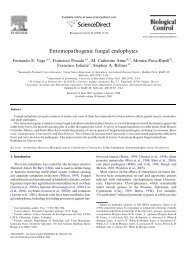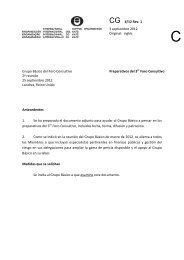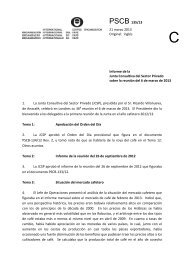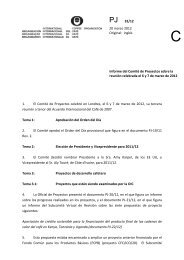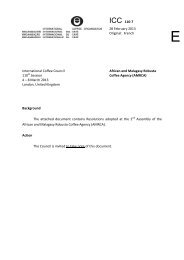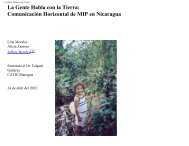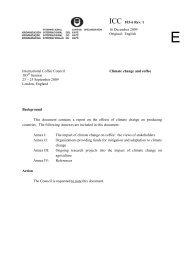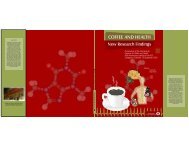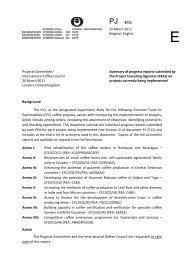Devouring profit - International Coffee Organization
Devouring profit - International Coffee Organization
Devouring profit - International Coffee Organization
You also want an ePaper? Increase the reach of your titles
YUMPU automatically turns print PDFs into web optimized ePapers that Google loves.
98<br />
qq 31 in 1999 to Rs 12,000/qq in 2000. A similar situation has occurred with areca nuts<br />
where prices fell from Rs 154/kg in September 1999 to Rs 78/kg a year later. The key<br />
point here is that the Indian agricultural sector is facing a difficult period that is affecting<br />
many crops, coffee included.<br />
<strong>Coffee</strong> planted areas have increased markedly in India over the last half century. In<br />
1950/51 there were 92,523 hectares; in 1999/00 the total area had grown to 340,306<br />
ha. We see in Figure 21 a very significant increase in total area during the 1970s and<br />
1980s. Arabica increased by about 100,000 hectares whilst robusta rose by 146,000<br />
ha. Areas planted in arabica and robusta are now roughly equal.<br />
<strong>Coffee</strong> production in India: for the year 1950/51 it was estimated at about 18,893<br />
Hectares<br />
350,000<br />
300,000<br />
250,000<br />
200,000<br />
150,000<br />
100,000<br />
50,000<br />
0<br />
Total Area<br />
Figure 21. Area planted in <strong>Coffee</strong>. India, 1978 – 1992 32 .<br />
31 Rs 48 = US$1 (2001)<br />
32 Source: <strong>Coffee</strong> Board, India, 2001<br />
Robusta<br />
Arabica<br />
50-51 70-71 90-91 92-93 94-95 96-97 98-99<br />
<strong>Coffee</strong> years<br />
metric tonnes while in 2000/01 about 295,000 metric tonnes (<strong>Coffee</strong> Board, 2000).<br />
<strong>Coffee</strong> productivity in India: in 1950-51 it was about 255 kg of parchment/ha while in<br />
2000-01 the expected productivity was about 1,084 kg of parchment/ha. This suggests<br />
that crop technology has been responsible for this change in productivity. So even<br />
without expansion in area, there may still be considerable scope for an increase in<br />
total production.<br />
Arabica and robusta are classified according to the post-harvesting method: “washed”<br />
and “non-washed” (naturals), and are classified into 25 grades based on the size of the<br />
bean and on the total number of defects or imperfections (ICO, 1997). Apart from<br />
this system, specialty coffee is now the fastest growing segment and India hopes to




